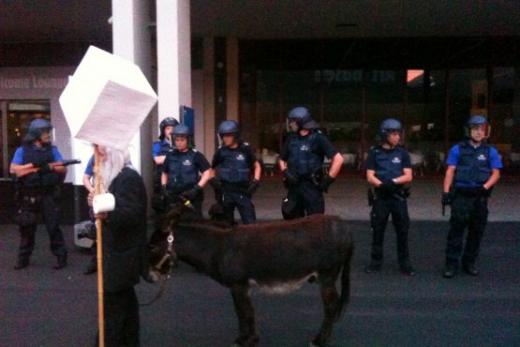Artists and other Animals
Artists and other Animals

Maybe it was the alcohol, the lack of sleep, the constant flying or the fact that I kept bumping into Carolyn Christov-Bakargiev in Venice. While landing in Zurich last week I heard cows (the sound of cows: muuuuh). Twenty hours later it happened again. Overhearing an art dealer talking to an eager collector couple in front of what looked like a "pommel horse” in gymnastics. “120.000 for the work and 40.000 for the cow”. I turned my head (what cow??)- but there was none.
We will go back to dealing with the simpler logistics of finding a gallerist soon enough, but maybe in honor (and in awe) of Art Basel we can leap into some hardcore art-economics. This is a marketing system, know as the growth-share matrix created by Boston Counsulting group to help corporations analyse the value-costs relation and market potential of their product lines. These terms, for which I of course take no credit for, have slipped in the art - language describing artists and their position (market value) in the gallery program.

- Cash Cows: are units that typically generate a lot of cash with low production and maintenance costs. They have a high market share, but a low/slow growing potential. They are regarded as safe and boring, but every gallery would be thrilled to own as many as possible. Mid career or established painters are a very good example. "They are to be "milked" continuously with as little investment as possible since such investment would be wasted in an industry with low growth."
- Dogs (more charitably called pets), are units that bring neither a lot of cash nor growth potential into the deal. These units typically barely "break even". I would not like to jeopardize my status in the Berlin Farm by stating which artists would qualify for this market position. I would assume it is art practises that are hard to sell, but bring social connections, press, status, or even artists with famous last names or emotional bonds with the gallery. "Dogs, it is thought, should be sold off."
- Question marks (also known as problem children) show a great growth potential, consume large amounts of cash to achieve it, but do not (for the time being) generate a lot of cash in return. The main reason to risk investing in a Question Mark is because it has the potential to become a star (see below), or even a cash cow when the market growth slows after a few years. If all goes wrong the question mark will turn into a dog and you will not get your money back. Young artists with high production and transport costs are a good example for this category, having the potential to turn into a mega museum career, or - well- not. Not every gallery has stars, but they should all take in some question marks every now and then. "Question marks must be analyzed carefully in order to determine whether they are worth the investment required".
- Stars are units that bring a lot of money, are growing fast and have high potential. The hope is that stars will stay stars for as long as possible and then become the next cash cows, when everything slows down. Stars are the market leaders. No introductions necessary. Cyprien Gaillard is for example a star we all watched growing. "Sustaining stars may require extra cash, but this is worthwhile if that's what it takes for the unit to remain a leader."
-One trick pony: This is not a marketing term, at least not officially. — It is used to describe an artist with only one single type of work (technique), which sells well and thus repeated again and again (before turning into a ... DOG). One trick ponies are of course serious cash cows, but nobody would admit to owning one, at least not out loud. Examples and oppinions on who qualifies as a 1TP could vary, depending where you stand in the Murillo - Aids 3d scala.
No gallery in their right mind would participate in a high cost fair such as Art Basel without at least one Cash Cow. Some go Cash-cow-only, like CFA or Gavin Brown for example, although they might see it as an all-Star line up. A lot of galleries risk with Question Marks, usually in the designated categories (Statements and Liste) and some even bring their dogs. Seems the one animal nobody cares for is a donkey.
PLEASE NOTE: The terms are freely interpreted for the needs of this post, sentences in brackets are directly transfered from the wikipedia post, but slightly off context.
ALSO NOTE: Thanks to my very good friend, awesome artist and graphs fanatic Ignacio Uriarte who points such things out to me.
